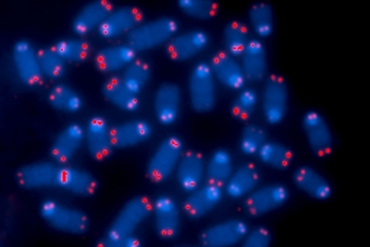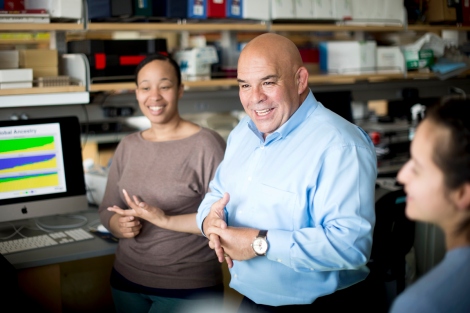Genetic Predictors of Lifespan Studied in Whites and Asians Don’t Apply to Black Youth
Study of Bay Area African-American Youth Identifies New Genetic Markers to Aid Study of Telomere Shortening Associated with Decreased Lifespan

Protective caps at the ends of our chromosomes called telomeres protect our cells’ genomic information but shorten each time a cell divides. This shortening of telomeres has been linked to aging and chronic diseases. For example, previous studies have shown that individuals with asthma have shorter telomeres than those without asthma, but it is unclear whether shorter telomeres are a cause or a consequence of the disease.
In the last decade, several studies have tried to overcome this conundrum by identifying genetic predictors of telomere length to allow researchers to separate genetic and environmental drivers of telomere shortening later in life. Based on more than 30 population-based studies of disease risk, telomere researchers have identified a set of these genetic predictors as standard proxies for telomere length.
However, there are well-known variations in telomere length due to age and racial/ethnic background whose genetic basis is still not well understood. Specifically, telomere shortening is most rapid in early life and throughout adolescence – after that most people’s telomeres shorten at about the same rate. Additionally, African-Americans have been shown to have longer telomeres throughout life than European Americans as well as – paradoxically – an accelerated rate of telomere shortening. But despite these important factors, nearly all studies of telomere genetics have been performed in adult populations of European or Asian ancestry, meaning that studies aiming to understand how early environmental exposures impact telomere length across different ethnic groups can’t easily assess the role of natural variations in telomere biology.

To fill this gap in knowledge about genetic markers of telomere shortening in African-American youth, the UCSF Asthma Collaboratory, led by principal investigator Esteban Burchard, MD, MPH, of the Department of Bioengineering and Therapeutic Sciences, a joint department of the UCSF Schools of Pharmacy and Medicine, investigated genetic associations with telomere length in 492 healthy individuals under the age of 20 from their ongoing Study of African-Americans, Asthma, Genes and Environments (SAGE). Their results were published Sept. 5, 2018, in Scientific Reports, an open-access online journal published by Nature Publishing Group.
In the new study, researchers led by co-first authors Andy Zeiger, a junior research specialist in the Asthma Collaboratory, and Marquitta White, PhD, an assistant professor, evaluated 40 previously identified genetic predictors of telomere length to see if they accurately predicted telomere length in this study population. They examined 34 commonly cited variants identified in prior studies of Caucasian and Asian adults, as well as six variants identified in a previous European study of Caucasian children, but found that none of these genetic variants were significantly associated with telomere length in African-American youth.
The researchers then performed a genome wide association study (GWAS) that identified one novel significant genetic variant associated with telomere length in the young SAGE participants, as well as several variants in genes and pathways highly relevant to telomere biology but which were only loosely associated with telomere length per se in this study group.
“This work represents the first investigation into genetic associations with telomere length in minority youth,” said Zeiger. “We showed that current genetic predictors are not generalizable to our study population of African-American youth, a finding that highlights the lack of population diversity in biomedical research. Fully understanding telomere dynamics requires investigations that span different ages and populations.”
The current study only examined snapshots of telomere length in SAGE participants at a single point in time, but the researchers hope that future studies will collect telomere measurements over many years to better understand the dynamic and complex relationships between telomere length and health. Such long-term investigations of telomere length starting at birth could shed light on the clinical implications of this relationship and improve physician-scientists’ ability to predict, prevent, and respond to disease.
Authors: The new study’s first authors were Andrew Zeiger and Marquitta White, PhD, who contributed equally to the research. Zeiger is a junior research specialist in the Asthma Collaboratory and White is an assistant professor in UCSF’s Department of Medicine and the study’s corresponding author. The study’s senior author was Esteban G. Burchard, MD, MPH, who is Harry Wm. and Diana V. Hind Distinguished Professor in Pharmaceutical Sciences II and a professor in UCSF’s Department of Bioengineering & Therapeutic Sciences and Department of Medicine.
Additional UCSF authors were Celeste Eng, Sam Oh, PhD, MPH, Jonathan Witonsky, MD, Pagé Goddard, Jennifer Liberto Elhawary, MS, Donglei Hu, PhD, Angel Mak, PhD, Eunice Lee, PhD, Kevin Keys, PhD, Lesly-Anne Samedy, PharmD, PhD, Joaquín Magaña, Scott Huntsman, MS, Sandra Salazar, and Kirsten Bibbins-Domingo, MD, PhD, MAS, as well as Adam Davis, MA, MPH, and Kelley Meade, MD, of UCSF Benioff Children’s Hospital Oakland Research Institute (CHORI). Other authors were Maria Contreras of San Francisco State University; Oona Risse-Adams of Lowell High School in San Francisco; Emerita Brigino Buenaventura, MD, of Kaiser Permanente Vallejo Medical Center; Michael LeNoir, MD, of Bay Area Pediatrics in Oakland; Harold Farber, MD, MSPH, of Baylor College of Medicine and Texas Children’s Hospital in Houston; and Luisa Borrell, DDS, PhD, of the City University of New York.
Funding: This work was supported in part by the Sandler Family Foundation; the American
Asthma Foundation; the RWJF Amos Medical Faculty Development Program; the Harry Wm. and Diana V. Hind Distinguished Professor in Pharmaceutical Sciences II; and the US National Institutes of Health’s National Heart, Lung, and Blood Institute (R01HL117004, R01HL128439, R01HL135156, X01HL134589, R01HL141992), National Institute of Environmental Health Sciences (R01ES015794, R21ES24844), National Institute on Minority Health and Health Disparities (P60MD006902, R01MD010443, RL5GM118984) and the Tobacco-Related Disease Research Program (24RT-0025, 27IR-0030). See study online for additional funding information.
Disclosures: The authors declare no competing interests.
UC San Francisco (UCSF) is a leading university dedicated to promoting health worldwide through advanced biomedical research, graduate-level education in the life sciences and health professions, and excellence in patient care. It includes top-ranked graduate schools of dentistry, medicine, nursing and pharmacy; a graduate division with nationally renowned programs in basic, biomedical, translational and population sciences; and a preeminent biomedical research enterprise. It also includes UCSF Health, which comprises three top-ranked hospitals – UCSF Medical Center and UCSF Benioff Children’s Hospitals in San Francisco and Oakland – as well as Langley Porter Psychiatric Hospital and Clinics, UCSF Benioff Children’s Physicians and the UCSF Faculty Practice. UCSF Health has affiliations with hospitals and health organizations throughout the Bay Area. UCSF faculty also provide all physician care at the public Zuckerberg San Francisco General Hospital and Trauma Center, and the SF VA Medical Center. The UCSF Fresno Medical Education Program is a major branch of the University of California, San Francisco’s School of Medicine.